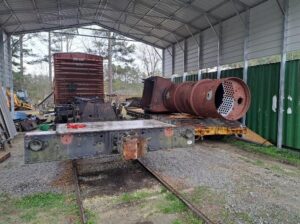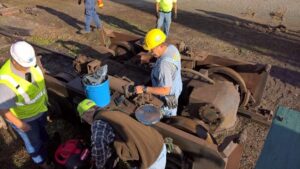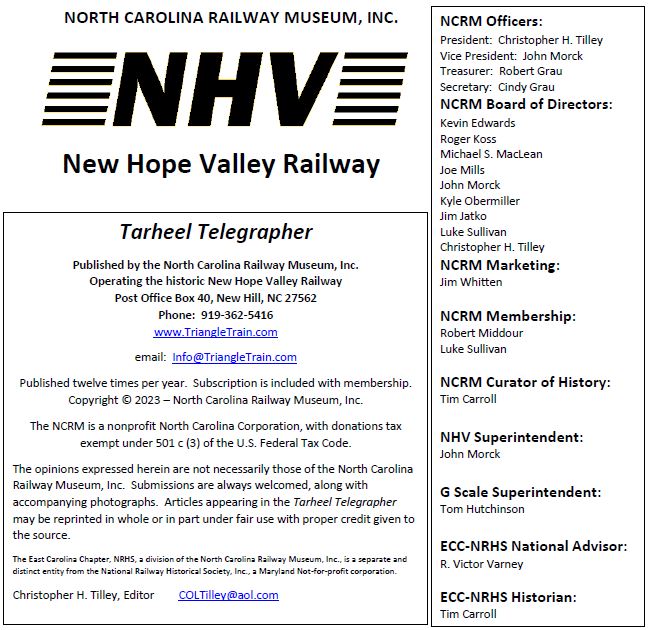Volume 63 – Issue 4 4 April 2023
From the Brass Hat
Greetings from the sunny Florida Keys! As you read this, opening day is now in the books. Thanks to everyone who had a hand in preparing and executing. While preparations for Hop Into Spring were ongoing, we had a contract crew replacing some crossties near the entrance to New Hill Yard. We got behind the eight ball on tie replacement due to the forced closures associated with COVID-19, so the Board of Directors allocated some funding to help get caught up.
Plenty of steam-related work has also been happening. As you saw in last month’s Tarheel Telegrapher, the heavy trailer was refurbished. Since then, #17 was pulled out of the shed and the boiler was lifted off the frame. The boiler currently resides on the trailer (laid on its side) to allow for additional welding and riveting as the new smokebox is installed. This is very exciting news. The trailer was rolled into the shed, next to #17, to stay protected from the weather.
Don’t forget, the quarterly Membership Meeting is 15 April at 10AM at the gazebo. This is a good opportunity to learn and provide your input to the workings of our Museum and Railway. Membership ballot included in this newsletter. Ballots are due and will be counted at the beginning of the meeting.
Thanks for all you do for our Museum. 2023 is turning into a great year!
Respectfully submitted,
Chris Tilley
President, NCRM
The New Hope Valley Garden Railway Story
by Tom Hutchinson
History-
Karl Kleeman founded the New Hope Valley Garden Railway in the fall of 2000. Karl rounded up a small group of five more volunteers to help, and in January 2001, construction began adjacent to the
 parking lots at the North Carolina Railway Museum and New Hope Valley Railway. To overcome drainage problems, the track was installed on used railroad ties, initially forming two ovals, one sixty feet long and the other eighty feet long. Due to work and other commitments, the original six volunteers dwindled down to a group of three, running live steam and electric engines on the Aristo-Craft solid rail tracks during the 2001 season. By the end of 2001, Karl had moved to Washington State, and we were down to two tired but dedicated volunteers, Dick Sossomon and Allen Coburn.
parking lots at the North Carolina Railway Museum and New Hope Valley Railway. To overcome drainage problems, the track was installed on used railroad ties, initially forming two ovals, one sixty feet long and the other eighty feet long. Due to work and other commitments, the original six volunteers dwindled down to a group of three, running live steam and electric engines on the Aristo-Craft solid rail tracks during the 2001 season. By the end of 2001, Karl had moved to Washington State, and we were down to two tired but dedicated volunteers, Dick Sossomon and Allen Coburn.
In January 2002, tons of spikes, tie plates, rail, joiners, wheels, and other items were moved so the garden railroad could be expanded. After the area was cleared, it was graded. Used railroad ties formed the borders, with the roadbed built of packed topsoil and four inches of size 57 gravel. A 1967 Massey Ferguson 10hp garden tractor was put to good use packing and leveling the dirt. After several weeks, the roadbed was completed, and the first tracks were laid. Bob Jordan built a twelve-foot-long, three track overhead truss bridge over the “pond.”
In August and September of 2002, a four-foot-high chain link fence was installed around the layout to keep visitors and equipment safe, along with car covers for shade. In November, the Boy Scouts helped install railroad ties for the inner retaining wall. Their help was greatly appreciated. In December, long trains ran and our volunteers faced cold wind chills while talking to the crowds. Chris Siegl, long-time New Hope Valley Board member and Rusty Spike recipient, joined the train volunteers during this time.
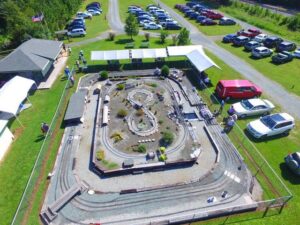 In early 2003, some soil was acquired for the inner railway, but the 2003 season was so rainy that little construction was done on the layout center. In 2004, more soil was purchased with donated funds, leveled, packed and allowed to settle. In 2005, the inner portion of the layout was developed with 3 separate loops: two oval loops and a figure 8 over and under track. A pond with waterfall were added then switches, passing sidings and a steam up shelf for live steam engines. In November an international live steam weekend was held. Not only were five live steam trains running at the same time, but volunteers were also giving demonstrations on live steam engine maintenance, concrete bridge abutment making, building and people painting, and electrical tower making. Thanks to these volunteers, the garden railway was off to a good start and has been able to evolve and improve over the last 23 years.
In early 2003, some soil was acquired for the inner railway, but the 2003 season was so rainy that little construction was done on the layout center. In 2004, more soil was purchased with donated funds, leveled, packed and allowed to settle. In 2005, the inner portion of the layout was developed with 3 separate loops: two oval loops and a figure 8 over and under track. A pond with waterfall were added then switches, passing sidings and a steam up shelf for live steam engines. In November an international live steam weekend was held. Not only were five live steam trains running at the same time, but volunteers were also giving demonstrations on live steam engine maintenance, concrete bridge abutment making, building and people painting, and electrical tower making. Thanks to these volunteers, the garden railway was off to a good start and has been able to evolve and improve over the last 23 years.
Current Operations –
A small dedicated core of New Hope Valley Railway volunteers spend much of their time ensuring that our garden railway, which is the first thing our visitors see, is operating smoothly. For many of our younger guests, seeing the garden railway with Thomas the Tank Engine, Percy, James and numerous Minions is a highlight of their visit.
 The garden railway would not be the attraction that it is today without the long-term efforts of our late Garden Railway Superintendent (and Rusty Spike holder)
The garden railway would not be the attraction that it is today without the long-term efforts of our late Garden Railway Superintendent (and Rusty Spike holder)
Chris Siegl, who was instrumental in its growth over the last twenty years. Chris also arranged for several Boy Scouts to do Eagle Projects to improve the railroad, including most recently the large wooden red locomotive play structure that is a hit among our pre-school visitors.
In addition to those who operate trains on every ride day (which takes from two to four volunteers), several volunteers also contribute specific talents. Jeff Portzer is the Master Gardener, Randy Evers is using his engineering background to reconfigure the wiring and electronics and Jordan DuVall has been working though our shelf of inoperable G-Scale locomotives and has brought over a half-dozen of them back to life through his repair expertise. The garden railway has retaining walls made from used (full-scale) railroad ties, a dozen of which had rotted beyond repair over the past 20 years, so last year a work crew of Scott Gagnon, Don Imbriale, Paul Staller, Randy Evers, Dave Graham and Tom Hutchinson did the heavy work of tie removal and replacement, and Scott and Don repainted the loco play structure which was starting to show wear. Kevin O’Connor, Brad Hackman and Alan Servas, three of our newer operators, are currently getting the hang of ride-day operations. Wednesday crew members Jeff, Scott, Tom, and Brad, along with Wednesday Crew member Mike McKinney, keep the area weeded, trimmed and mowed. The garden railway volunteers also provide for the maintenance, set-up, take-down and a good portion of the staffing of a garden railway that is constructed in the horticulture area at each year’s North Carolina State Fair. This is a great opportunity for the New Hope Valley to increase its visibility in the Triangle.
One of our local Triangle garden railroad hobbyists, Joe Austin, is also a member of our museum, along with his wife Jeanne. Each year, on one of our fall operating
days, the garden railway hosts a Thomas-themed day for our younger visitors. Joe had a complete collection of Thomas-themed locos and rolling stock which he generously donated to our museum…all in mint condition in their original boxes. Also included in his donation were three battery packs and a charger, as Joe has configured his locos to run on both track and battery power.
All of our volunteers are helping work through an ambitious list of long-term improvements to the garden railroad to ensure that it continues to evolve and improve.
The NCRM Archive is STILL Looking for a Few Good Telegraphers!
by Victor Varney
The effort to gather up and inventory in our new climate-controlled storage unit in Apex continues to make progress. Anita Hussey has done a great job going through now over 64 boxes of NCRM items brought to the storage unit for curation and safe keeping. Every single item in each box has been documented. Our first priority to document the history of the NCRM has been to assemble and file a complete collection of Tarheel Telegraphers. We are happy to report that we now have a complete collection of every single issue starting with Newsletter #1 from July 1964 to 1992 Vol 2-4 and every issue from 2006 to today. That said, after 1992 Vol 2-4 to the end of 2005 we are missing lots of issues. From the early 1990s through 2004 there are a variety of different formats used as well. These issues we do have sometimes are only a single page. We aren’t sure if there was only 1 page in some issues, or if pages got separated. If you have a collection of Telegraphers that can help us fill the gaps between 1992 to 2004, please consider donating them to us. They will help us fully document our history. We keep duplicates in our files so know that we won’t be throwing away any issues if we get them.
There is now a small box in the yard office where you can drop off your old Telegraphers. Or contact Victor Varney if you have any questions.
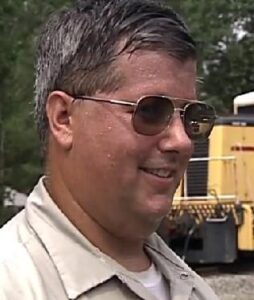 Back in the “Old Days” – The Story of “The Twins” – as told by M. Gray Lackey
Back in the “Old Days” – The Story of “The Twins” – as told by M. Gray Lackey
This is the story of the twins: Ex US Army 80 tonners 1640 and 1681 (now NHV 671).
Some of us first saw the twins back in 2008 when we were on the MOTSU (Military Ocean Terminal – Sunny Point) base inspecting some potential surplus items. We remarked at how we would love to have the two locomotives, but alas it was not to be as they were the engines a U.S. Army Reserve transportation unit used for their yearly training. The locomotives were forgotten about by us (almost) as being unobtainable.
Fast forward to September 7, 2016. Upon returning to work after chasing Norfolk and Western class J 611 south to Spencer, NC, I had a message waiting on my phone about two locomotives at Sunny Point that were going to be surplused and were we interested. A return call yielded that the two locomotives were indeed the Reserve Unit 80 tonners. After most of a day on the phone trying to track the units down for inspection, I finally had arrangements made for an inspection visit on September 14.
two locomotives at Sunny Point that were going to be surplused and were we interested. A return call yielded that the two locomotives were indeed the Reserve Unit 80 tonners. After most of a day on the phone trying to track the units down for inspection, I finally had arrangements made for an inspection visit on September 14.
Roger Koss, Joe Mills, Mack Lackey and myself arrived and got our visitor clearance and were taken to see the units. The locomotives were stored under a cover and as had been known previously had been rebuilt by Tooele Army Depot in 1990 to completely new specifications from the ground up. 1640 has 840 hours of use and 1681 has 716 hours of use. We were told that they had been running approximately two years before. Everything looked good and the next action would be consideration by the BOD the next evening at the regular meeting.
The BOD authorized requesting the locomotives and a formal request was placed, but it would be September 20 before we would know anything. Waiting can be a very laborious process that seems to make time slow to various degrees depending on anticipation. I received a call early morning on September 20 informing me that we had been awarded both locomotives. Great news, but problematic timing with Halloween and Christmas coming up. Planning started with some fits and starts and we were getting pressure from the military surplus people to move them.
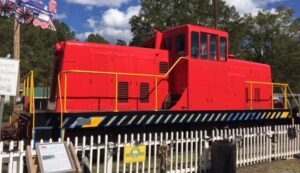 We arranged for a work session the first week of November and were going to move the next week as we were still getting pressure to move them. As a fine example of one hand of The Government not knowing what the other was doing, when we arrived at MOTSU November 3 and started to talk dates, they stated that they couldn’t do that as they were busy with prior planned operations. I explained the situation that we were getting pressure, but putting off until early January worked for us if it worked for them. We completed our work session and after a couple of weeks MOTSU informed me that they would be available the week January 9-13 to load us out. Phone calls back and forth commenced and we had some good news, MOTSU would load the locomotives for us. Great, lots of money and time saved. WAIT, phone rings again after about fifteen minutes, we can’t load the engines, they weigh too much, our cranes are only rated at 60 tons and the locomotives weigh 80 tons. No problem I responded since we are going to take the trucks out from under them for road transport purposes so the locomotive bodies weigh 56 tons and the trucks 12 tons each. OK let me call you back. Phone rings again, we can load you, great, FIRST crisis averted.
We arranged for a work session the first week of November and were going to move the next week as we were still getting pressure to move them. As a fine example of one hand of The Government not knowing what the other was doing, when we arrived at MOTSU November 3 and started to talk dates, they stated that they couldn’t do that as they were busy with prior planned operations. I explained the situation that we were getting pressure, but putting off until early January worked for us if it worked for them. We completed our work session and after a couple of weeks MOTSU informed me that they would be available the week January 9-13 to load us out. Phone calls back and forth commenced and we had some good news, MOTSU would load the locomotives for us. Great, lots of money and time saved. WAIT, phone rings again after about fifteen minutes, we can’t load the engines, they weigh too much, our cranes are only rated at 60 tons and the locomotives weigh 80 tons. No problem I responded since we are going to take the trucks out from under them for road transport purposes so the locomotive bodies weigh 56 tons and the trucks 12 tons each. OK let me call you back. Phone rings again, we can load you, great, FIRST crisis averted.

Artist’s concept of the NS color scheme adapted to a locomotive type they never had. (Gray Lackey artwork)
Planning started in earnest for a January 9-13 move, arranging the trucks and unloading arrangements at Bonsal plus a timeline so everyone knew what was going on. Halloween came and went, then Christmas and we were set to go – UNTIL: I received a call late afternoon on January 4 to verify we were bringing rigging as I had been asking about rigging at MOTSU all along. Since MOTSU is a container port, I was told they don’t have any rigging . Panic set in BIG TIME. I called Ken Eder who was going to unload them for us and he said to be at his yard in Carthage the next day at 7:00 to pick up four lifting cables. While I was in Carthage, Roger Koss went to Carolina Chain and Cable to purchase eight seventeen-ton shackles and four lifting straps. SECOND Crisis averted.
At our request and MOTSU’s agreement, Roger and I were going back January 6 to check rigging and meet with the crane supervisor. Everything went well, everything was going to work and we finalized the schedule for all involved. All the while the forecast for bad weather was getting more and more positive that the weather was going more negative and negative. Friday night January 6 – SNOW. We had a meeting scheduled to discuss all the move aspects the next day, (Saturday the 7th) and while some couldn’t make it, we had enough to discuss the unloading at Bonsal. The loading part of the meeting would have to be handled at MOTSU Monday morning. Four-wheel drive got us to Bonsal, we had our meeting and plugged the 240V block heaters in on 1686 as the temperatures were going to be extremely cold and we were going to need her to crank. Major roads were getting somewhat better in time for the trip home and to load. THIRD Crisis averted.

Artist’s concept of the NS gray color scheme adapted to a locomotive type they never had. (Gray Lackey artwork)
Sunday January 8 dawned and John Treadway, Ray Albers, Harold Boettcher, Roger Koss and myself were on the road to MOTSU. Rob Grau would meet us there Monday morning. Luckily, the area around Sunny Point was not affected by the inclement weather and Oak Island where we were staying was a warm 28 degrees, that is compared to the single digits around Raleigh. On Monday January 9, after getting ID badges made and checking in with our contacts, we were on the wharf doing a final take apart getting ready to load. Yarbrough Transfer called me and I passed the word along, that they were going to be a little later than planned due to the temperatures in Winston Salem where they had to leave from being 4 degrees and vehicles were hard to get started.
Yarbrough got to the Wharf about 1:00 and started putting the trailer together (13 axles is easier to move in pieces). We had already lifted the locomotive body slightly and were ready to go when they were. Loading and blocking is not a fast job but went smoothly. While Yarbrough was tying down (with LOTS of chains) the locomotive’s trucks were being loaded on a Harnett Transportation truck. We were done at the wharf by 3:30. The weather was very nice on the wharf with a high of 38 degrees and a 15-knot wind. Zipped up coats with appropriate PPE were the order of the day. Since over-dimensional loads cannot move at night, there was not enough time after clearing security back out of the base to go anywhere so the body stayed on the side of the MOTSU access road overnight while many went to watch the football game. Since the locomotive’s trucks were not over dimensional, they could travel any time and Roger went back to Bonsal with them to unload Tuesday morning.
On Tuesday January 10, the locomotive body got underway about 7:45 and while I had to stay behind to sign some papers later that morning, good use was made of the time to go to the rail shop and get any books concerning the locomotives.
Eight two-inch binders plus some loose papers came back with me. After taking care of the needed papers, I left the gate and beat the truck to Bonsal by 10 minutes. The trucks were already unloaded by Roger, Scott Smith and others. I got a call from Ken Eder stating he was having some equipment trouble but was coming, he wasn’t sure of the exit so I went and got them at the Merry Oaks exit on US 1. I drove to Merry Oaks and backed up the shoulder of the off ramp and parked in the gore point waiting on Mid East. I saw a cloud before I saw the cranes. A sizable air leak had developed on one of the crane dollies and enough air pressure was being lost that the parking brakes were trying to set. While in motion, there was enough air flow to keep the tires somewhat cool, but as speed decreased heat built up. Just as the crane turned onto Daisy street – BOOM, then just after the tracks were crossed another- BOOM, two tires had blown. Chris Tilley remarked he had not heard that sound since hearing Howitzers firing from his Army days. But at least the cranes could now sit on the rails and proceed to unload. FOURTH crisis averted!
Ken got things set the way he wanted and after a while the lift was ready. The soft ground meant extra blocking was needed and things weren’t exactly perfect but things would work. The trucks were pushed into place and the lift started – after what was a short time but seemed an eternity the first engine (1640) was on its wheels at Bonsal. The cranes were moved and the trailer taken apart again for the second trip to MOTSU. The crane that had the air leak stayed at Bonsal to be repaired the next day. The truck got as far as the rest stop at Warsaw before stopping for the night, while I was on my way back to Oak Island. Roger, Joe Mills and Rob Grau would meet us at MOTSU the morning of January 11.
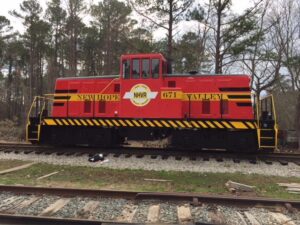 Everyone was on the wharf for the second load by 8:30. The truck had to leave from Warsaw after sunrise and got there along with Harnett Transportation a little before 10:00. Same story as before concerning the trailer, and since this was now a proven exercise, we were by ourselves except for the crane operator and ground man to proceed. Loading and blocking took a little longer due to a different valve placement on the fuel tank, but all still went well. The big truck was escorted out and I escorted the truck with the locomotive trucks out. We checked out and thanked everyone and were all on our way back to Bonsal with the same time constraints. I followed the truck up and we passed the last rest area around 2:00. The truck with the second locomotive (1640) WAS GOING to be at Bonsal that night. The truck got to Bonsal around 5:00 and parked. Nothing would happen until Thursday, January 12th. I was on my way home for the night.
Everyone was on the wharf for the second load by 8:30. The truck had to leave from Warsaw after sunrise and got there along with Harnett Transportation a little before 10:00. Same story as before concerning the trailer, and since this was now a proven exercise, we were by ourselves except for the crane operator and ground man to proceed. Loading and blocking took a little longer due to a different valve placement on the fuel tank, but all still went well. The big truck was escorted out and I escorted the truck with the locomotive trucks out. We checked out and thanked everyone and were all on our way back to Bonsal with the same time constraints. I followed the truck up and we passed the last rest area around 2:00. The truck with the second locomotive (1640) WAS GOING to be at Bonsal that night. The truck got to Bonsal around 5:00 and parked. Nothing would happen until Thursday, January 12th. I was on my way home for the night.
Back to Bonsal before 8:00 to move the 1686 and 1640 out of the way. Yarbrough was there around 8:30 as well as Harnett Transportation with the locomotive trucks. Ken Eder got there just a few minutes later and started setting up the cranes. We were able to get the body a little closer to the tracks and after unloading the trucks, this lift went really smooth. The body was set and all equipment gone by 11:00. A little switching and some pictures and everyone was gone by noon.
Ultimately everything went well, the only issues were two tires that blew in transit on one of the cranes and a minor finger cut. Safety is always the word and we pulled off two big jobs with only one small issue. I can’t say enough about the people at MOTSU and how helpful and accommodating they were, that truly is your government at work doing good things. We now have two relatively new locomotives that you can still buy parts for that should help us keep running for a long while. Over 2000 miles in 8 days including 6 vacation days from work. Even though it is work, this is what I call fun and wouldn’t trade the experiences.
[Editor’s note: If you have photos or other info about long-ago events at the NCRM, please contact your editor. You can submit your own “Back in the Old Days…” article with pictures about anything (within reason) from our past for the Telegrapher. If you can rough out the ideas, we can work with you to craft an article to benefit the entire membership. – CT]
NCRM Rules and Safety Training Day Success
The first iteration of the NHV Rules and Safety training for 2023 took place on 25 March as scheduled. Twenty-seven members attended the event, with twenty-six taking and passing the rules test. This puts us in a good position for maintaining our currency. As a reminder, FRA regulations require all operating crew to attend at least one of these sessions per year to maintain crew currency standards. If you were not able to attend this one and also missed the later iterations in 2022, please contact Rules & Safety Chair Kevin Edwards to let him know you are in danger of becoming uncurrent. We may be able to arrange a make-up class. Thanks to all who participated!
If you do not receive crew calls, please contact the crew caller if you are interested in participating!
 You may print this page and turn in at the meeting. Printed ballots will be available at the meeting as well.
You may print this page and turn in at the meeting. Printed ballots will be available at the meeting as well.
 NOTE: Safety meeting 1 hour before all listed train movements. Crew calls issued 1 week prior from Chris Tilley.
NOTE: Safety meeting 1 hour before all listed train movements. Crew calls issued 1 week prior from Chris Tilley.


